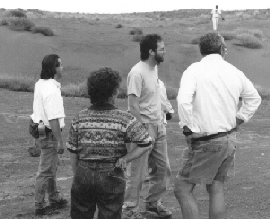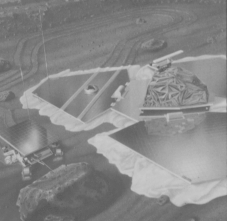

by Ken Edgett and Jim Rice
Arizona State University
Tempe, Arizona
"It is exciting that eastern Washington is like the Martian landscape!" exclaimed Rachel, an eighth-grader who came to "Mars Night," a public open house held at Chase Middle School in Spokane, Wash., on September 28, 1995. "Mars Night" was attended by 700 local parents and children who came to learn more about NASA's Mars Exploration Program. "Mars Night" was just one part of a week of investigation and exploration by Mars Pathfinder personnel and K-12 educators.
Between September 24 and 30, eastern Washington drew in a crowd of more than 50 Mars scientists and Mars Pathfinder project engineers eager to learn more about the kind of terrain that Mars Pathfinder may encounter when it lands on July 4, 1997.
The group was joined by thirteen K-12 educators from Washington and Idaho. The teachers shared in the experience as Mars Pathfinder engineers and scientists puzzled over the potential for landing on similar martian terrain. The educators were selected in April 1995 on the basis of their plans to relay their experiences and knowledge with students, teachers, and parents in their communities after they returned home.
About 13,000 years ago, massive catastrophic floods swept across eastern Washington, carving the Channeled Scabland. Mars Pathfinder will land in similar terrain-- although Ares Vallis is about 20 times larger than any of the flood channels in the Scabland. The Washington floods were caused by the breaking of an ice dam in northern Idaho, which had held back the Ice Age Lake Missoula. As many as forty floods may have poured through the Spokane Valley, across Washington, down the Columbia River Gorge, and out into the Pacific Ocean.
Participants spent Sept. 24-27 on a field trip through terrain near Moses Lake, Wash., that scientists believe is most similar to the Ares Vallis region. They visited streamlined islands, giant ripples caused by floods, and a huge deposit of gravel and boulders.
The bouldery deposit, known to geologists as the Ephrata Fan, was a major attraction. Indeed, Mars Pathfinder engineers were alarmed by the size of boulders (one as big as a house!) that they saw on the first day. This concern led the group to alter its field trip plans the next day, so they could examine other sites on the Ephrata Fan. They learned that the covering of boulders and rocks on the fan varies across its surface-- something new to consider as plans go forward for the 1997 landing. For the most part, what the Mars Pathfinder team saw in Washington helped alleviate any lingering fears they might have had about landing in Ares Vallis.
The Mars Pathfinder Landing Site Workshop and Field Trips in Washington were sponsored by Arizona State University (Tempe, AZ), the Jet Propulsion Laboratory (Pasadena, CA), the Lunar and Planetary Institute (Houston, TX), and NASA.
The plan for combining Mars education and science goals in the Channeled Scabland was hatched by Jim Rice and Ken Edgett of Arizona State University about a year ago. The science workshop was convened by Mars Pathfinder Project Scientist Matt Golombek. The Field Trips were led by Vic Baker of the University of Arizona. "Mars Night" was coordinated by Heather Cassidy of Chase Middle School. The format of combined science and outreach objectives will likely serve as a model for future science meetings.
Within days after getting home, one of the thirteen educators, Fran O'Rourke of Everett, Wash., reported, "My students are going nuts and their parents are excited, too!" Jo Dodds of O'Leary Junior High School in Twin Falls, Idaho, added, "You have really set in motion great folks armed with enthusiasm, energy, and ideas... All day, every class period, we talked about the field trip."
Over the next few months, the thirteen educators will conduct public events, classroom studies, and teacher workshops to share what they learned. The real-life experiences and contacts they developed will make them a valuable resource for students and educators around the world to learn more about Mars Pathfinder and its mission.
"You made learning fun, not only for the youngest of children, but for the oldest of adults," wrote Ashley, a girl who attended the "Mars Night" at Chase Middle School. Indeed, the exploration of Mars provides opportunities for everyone to learn and enjoy something new.
Thomas C. Campbell Capital High School, Boise, ID Heather H. Cassidy Chase Middle School, Spokane, WA Jo Dodds O'Leary Junior High School, Twin Falls, ID Louise Fayette Toppenish Middle School, Toppenish, WA Chris M. Flanagan Centennial Middle School, Spokane, WA John Gallagher Port Angeles High School, Port Angeles, WA Maureen Harder Ritzville High School, Ritzville, WA Sheri Klug Marsing Middle School, Marsing, ID Michael A. Murray Alki Middle School, Vancouver, WA Keith Olive Wilson Middle School, Yakima, WA Dr. Meredith B. Olson Seattle Country Day School, Seattle, WA Fran O'Rourke Cedar Wood Elementary School, Bothell, WA Linda Selvig Centennial High School, Boise, ID